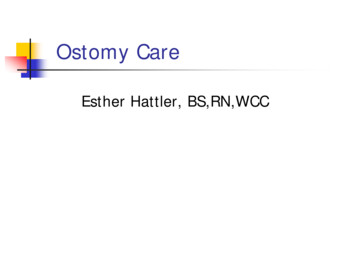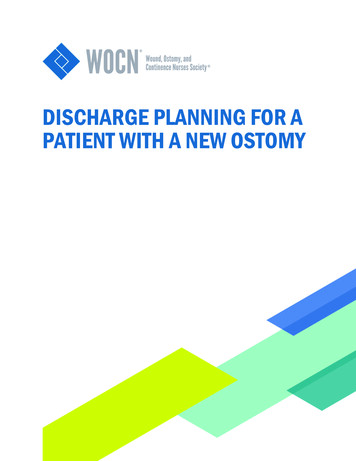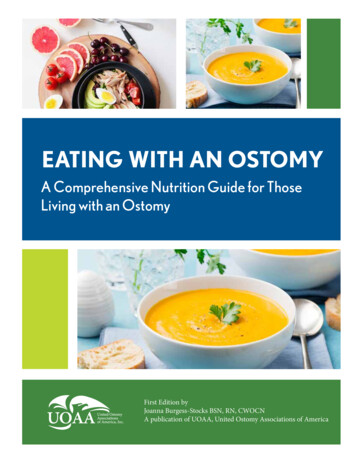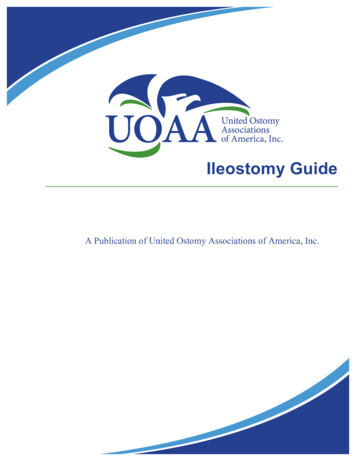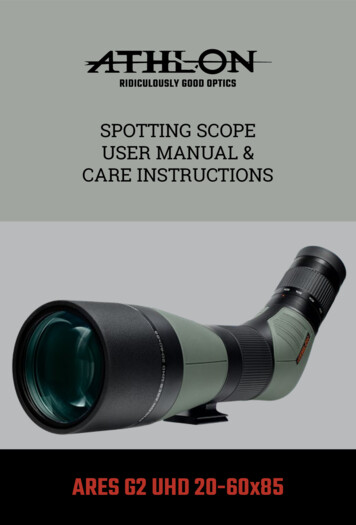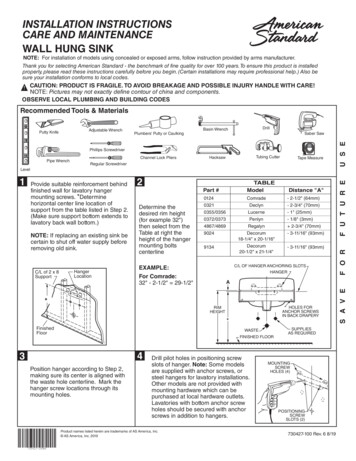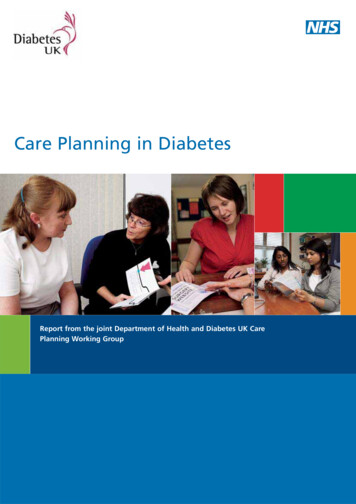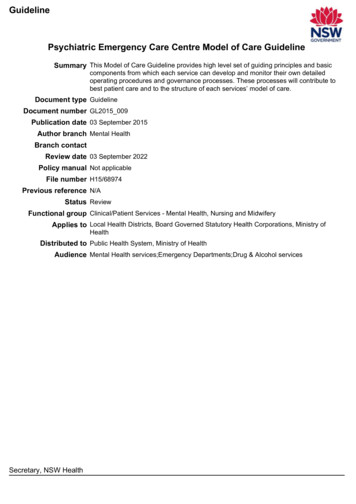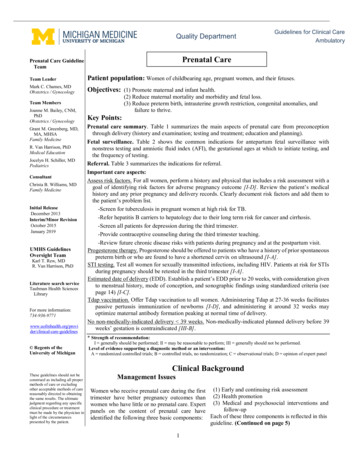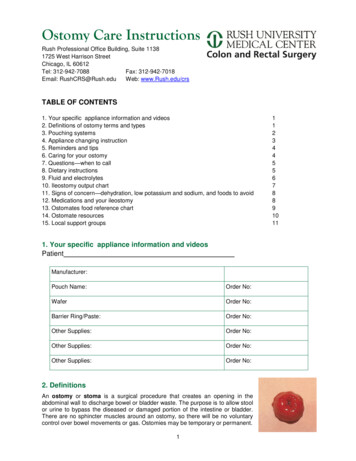
Transcription
Ostomy Care InstructionsRush Professional Office Building, Suite 11381725 West Harrison StreetChicago, IL 60612Tel: 312-942-7088Fax: 312-942-7018Email: RushCRS@Rush.eduWeb: www.Rush.edu/crsTABLE OF CONTENTS1. Your specific appliance information and videos2. Definitions of ostomy terms and types3. Pouching systems4. Appliance changing instruction5. Reminders and tips6. Caring for your ostomy7. Questions—when to call8. Dietary instructions9. Fluid and electrolytes10. Ileostomy output chart11. Signs of concern—dehydration, low potassium and sodium, and foods to avoid12. Medications and your ileostomy13. Ostomates food reference chart14. Ostomate resources15. Local support groups1. Your specific appliance information and videosPatientManufacturer:Pouch Name:Order No:WaferOrder No:Barrier Ring/Paste:Order No:Other Supplies:Order No:Other Supplies:Order No:Other Supplies:Order No:2. DefinitionsAn ostomy or stoma is a surgical procedure that creates an opening in theabdominal wall to discharge bowel or bladder waste. The purpose is to allow stoolor urine to bypass the diseased or damaged portion of the intestine or bladder.There are no sphincter muscles around an ostomy, so there will be no voluntarycontrol over bowel movements or gas. Ostomies may be temporary or permanent.111234455678891011
Proximal – Upper end or upstream in the intestine.Distal – Lower end or downstream in the intestine.Peristomal skin - The skin surrounding the ostomy. The skin should remain intact. Please contact yoursurgeon or WOCN if the peristomal skin becomes irritated.Colostomy - The colon exits through the abdominal wall. This new opening is where stool will beeliminated. Stool usually starts off liquid then may become more formed. A concern can be constipation.Ileostomy - The small intestine exits through the abdominal wall. Since the stool comes from the smallintestine the stool is usually liquid and contains digestive enzymes that can irritate your skin. This is why itis important to have little to no skin showing around your ostomy when you apply your skin barrier. Aconcern is dehydration and electrolyte imbalances.Urostomy - An ostomy created to divert urine away from the bladder. The urine exits through a shortpiece of intestine brought to the skin.End ostomy - The cut end of the intestine is brought through the abdominal wall to create a ostomy.Some of the colon and rectum may remain but are sutured closed and left below the surface.End ColostomyEnd IleostomyHartmann’s Procedure The intestine is divided, usually with removal of a section. The upper orproximal end is brought through the abdominal wall. The lower or distal endclosed off with staples or sutures and then left in the abdomen. This forms anon-functioning pouch which is open through the anus. Hartmann’s proceduresmay often be reverse or closed by disconnecting the ostomy from the skin andconnecting it to the closed lower end (Hartmann’s reversal).3. Pouching SystemsA pouching system or appliance has two parts – a faceplate that attaches tothe abdominal skin using adhesive, and a pouch to collect the waste. There aretwo types of pouching systems, a one piece and two piece system.The one piece system has the faceplate and the pouch as a single unit. Thereare fewer steps in applying the system so it is generally easier to apply. Thesesystems are also more flexible and will lay flatter against the body.The two piece system comes with the faceplate and the pouch as separatepieces. The two pieces snap together, similar to a Tupperware container andtop. This requires some hand strength and dexterity. The faceplate is fairly easyto apply since the ostomy can be seen through the hole in the middle. However,the faceplate is somewhat rigid. With this pouching system you can easilyexchange your pouch without having to change the faceplate.The faceplate (also called a skin barrier or wafer) sticks to the skin. Thefaceplate is designed to protect the skin from the output of the ostomy. Karaya2
is a gummy dark yellow colored material that is used in many faceplates. Whenit warms up to skin temperature, it gets softer and very sticky. Some faceplatesalso have tape around the edges for more protection. A hole must be cut in thecenter to the exact size of the stoma with very little skin showing between theinner edge of the faceplate and the ostomy. Many faceplates come with pre-cutround holes. Once your ostomy has healed and the size is stable, your WOCmay recommend buying pre-cut faceplates of a specific size.The pouch collects the stool or urine. It is odor proof. It should be emptiedwhen it is 1/3 to 1/2 full.An Adapt Barrier Ring can be used like a washerunderneath the wafer to help create a good seal.Adapt Paste is used to fill in or caulk uneven skin tocreate a flatter surface for the wafer to adhere.These are not adhesives.Stoma Powder is used to absorb moisture. It helps to protect raw andweeping skin. Use it sparingly as it may prevent your faceplate fromdeveloping a good seal.4. Appliance Change Instructions1. Gather equipment: Appropriate Pouch Adapt Ring or Stoma Paste Stoma Powder/ 3M No Sting Skin Barrier Wipe Washcloths (wet and dry)/Paper Towel Optional: mild, no residue, water based soap Scissors Measuring Guide Garbage bag2. Empty the pouch.3. Remove the skin barrier by using the “push-pull method” against your skin. Discard the pouch byplacing it in a plastic bag. Remember to save the clamp if using this type of closure.4. Use a dry cloth to remove the Adapt Ring or paste. Clean the skin well using warm water (You mayuse a washcloth or paper towels). Do not abrade or injure the skin. Be sure that skin around thestoma is completely dry before applying the faceplate.5. Measure your ostomy by using the measuring guide provided in your pouch box.6. Cut the pouch opening to the EXACT size and shape of your stoma. Making a pattern can be helpful.Your ostomy will be swollen for 6-8 weeks after surgery and will gradually get smaller, so the size ofthe opening in the faceplate will change. If using a 2 piece system you may snap the wafer and pouchtogether before applying.7. If the skin around the ostomy is red and irritated, place a dusting of Stoma Powder on the skin. Wipeoff the excess powder and seal it with 3M No Sting Skin Barrier.8. Skin folds or wrinkles may require a filler or caulking agent. Stoma Paste – Remove the protective paper from the adhesive side of the faceplate and apply aneven bead of paste to the around the rim of the cut hole. Set aside. Adapt Ring - Shape the ring to fit comfortably around the ostomy and apply directly to the skinaround the stoma.3
9. Apply the faceplate over the ostomy, centering the opening evenly. It may be placed right onto theAdapt Ring, if you are using one.10. Massage the skin barrier using light pressure around the stoma. Start directly next to the ostomy andwork out toward the edges. The warmth of your hands and the pressure will help to seal the paste orAdapt Ring.11. Close the bottom of the appliance with a clamp or with the attached strip. Hold your palm over theappliance and against your body for a few minutes.12. Attach the ostomy belt, if you use one.5. Reminders and Tips Empty your pouch when it is 1/3 to 1/2 full. A full pouch can get heavy and cause the appliance tolose a good seal and leak. The best time to change your appliance is when your bowel is the least active. Some people findthat this is in the morning before they have had anything to eat or drink. Others find that their bowelactivity is minimal two to three hours after meals. Right after your operation, your bowel movementswill be loose and watery. As your bowel movements thicken, it will be easier for you to determinethe best time to change your pouch. Change your pouch every 4-7 days. You may shower 3 days after laparoscopic surgery and 5 days after open surgery. Water may runover your incision and ostomy but do not scrub. Pat dry. No tub baths, swimming or hot tub until released by your physician. Showering and bathing will not hurt your ostomy or the appliance. Some people prefer to showerwithout their appliance on the days they change their pouching system. You can decide what youprefer. If you use soap make sure it does not contain any oils or lotions as this can interfere with howsecurely your faceplate adheres to your skin. Be sure to rinse the skin well. The residue from thesoap could prevent the faceplate from sticking as well. Dry your skin gently but well before applyingthe new faceplate. If you are using a 2 piece system you may apply the 2 pieces separately or together.6. Caring For Your Ostomy Whenever possible, stand when applying your ostomy appliance. This will help keep the skin aroundyour ostomy smooth and flat, and will improve the quality of the seal you get between your faceplateand the skin. If the skin around your ostomy wrinkles and creases even when you are standing, placeone hand several inches above your ostomy. Pull up on the skin until the skin around your ostomy issmooth. After your operation, your ostomy will be swollen. During the first 6 to 8 weeks after your operation,your ostomy will become smaller. During this time, it is important for you to measure your ostomyweekly and adjust the size of the opening in the faceplate. You may change to a pre-cut applianceonce your ostomy consistently remains the same size. Make sure you have enough appliances and ostomy supplies on hand to last you for three to fourweeks. Carry an extra appliance with you at all times. If you are admitted to a hospital, take yourostomy supplies with you. The hospital may not stock the brand or size appliance you use. Carry an emergency kit in case you have to change your appliance. The kit should include allsupplies that you use to change your appliance plus a change of clothes. Below is a list of suppliesthat can assist you in packing your emergency kit.o Skin Barriero Poucho Scissors4
oooooooPaper TowelsSkin Prep and/or Adhesive RemoverAdapt Rings and/or PasteStoma PowderMirrorBag to dispose of old pouchWaterproof tape7. Questions?Call the Wound Ostomy Continence (WOC) nurse if: You have questions regarding pouching your ostomy, There are unexpected changes in the output, You are experiencing skin problems that prevent your appliance from staying on or if you havepersistent leaks, You would like assistance with product selection and pouching tips, Unexpected changes occur in your ostomy, i.e. separation from the skin, sticking out or sinking in, The skin surrounding the stoma is irritated or painful, You have any other concerns related to the management of your ostomy.Call your doctor if: There is a substantial change in the color, size, or appearance of the ostomy,You have bleeding from the ostomy more than a few drops,You develop nausea, vomiting, cramping, or bloating that does not improve within an hour,You have little or no output from your ostomy for greater than 24 hours for a colostomy or 6 hoursfor an ileostomy, You need a prescription for ostomy supplies.You can contact a Rush University Medical Center ColorectalSurgeon or the WOC Nurse at 312-942-7088.8. Dietary InstructionsDue to swelling of the ostomy after surgery, we recommend that you eat a low residue diet for 3 weeks.Avoid high fiber foods which can cause blockage where the ostomy comes through the abdominal wallmuscles. The swelling should reduce in 3-4 weeks. After that time you may return to a regular diet.Foods allowed on low fiber dietRefined grain products with little bran: Low-fiber cereals with 0-1 gram of fiber per serving, white breads,saltines crackers, Melba/milk toast, low fiber pastasPotatoes: Boiled, baked, creamed, and mashed white potatoes without the skinWhite riceVegetables: Tender, well-cooked vegetable – limited. Peeled cucumbers. Vegetable juices without seedsor pulpFruits: Canned, baked or stewed without skins or seeds. Fruit juices with no pulpMeats: Hamburger, tender meat – limited and well chewed, poultry – chicken and turkey, not fried orbreaded, fish, seafoodDairy (if tolerated): Milk, ice cream, yogurt, puddings, butter and mayonnaise, mild cheeses without addednuts, fruitSmooth salad dressings, margarine, oilsBroth-based soups and cream-based soups, strainedEggs - Soft, baked, boiled, hard, scrambled, poached or souffléSweets - White sugar, brown sugar, clear jelly, honey, molasses, hard candy, gum drop, chocolate syrup,maple syrupSpices - salt and mild seasonings, cinnamon, paprika, lemon, vanilla5
Foods to avoid on low fiber dietFried foods: Eggs, cheeses, fried potatoes, potato skins, potato chips, french fries.Whole-grain breads, cereals, crackers and pasta, graham crackers, pretzels, pancakes, waffles, muffins,corn bread, quick-breadsWhole grain rice, barley, etcTough or coarse meats with gristle, luncheon meats or cheese with seedsPeanut butterWhole and raw vegetables, skins, seeds and vegetable sauces; Chinese vegetable, stir fries, fibrousvegetables including whole kernel corn, beans, peas, sweet potatoes, cauliflower, asparagus,mushrooms, broccoli, raw carrots, zucchini, and squashRaw vegetables, vegetables with skins or seedsRaw fruits, fruits with skins or seeds, raisins, dates, figs, canned plume, berries, fruit cocktail, pineapple,strawberries. Cooked whole fruits and canned fruitsYogurt, pudding, ice cream or cream-based soups containing nuts, fruits or vegetablesSeeds and nutsCandies containing fruit or nuts, jams, marmaladeJams with fruit, marmaladeCoconut , popcornDietary recommendationsEat 5-6 small meals a day. Ensure your diet is well balanced including food from all food groups: 2-3 servings of dairy products 2-3 servings of protein (meats, fish, beans, eggs, and nuts) 6-11 servings of breads and cereal 2-4 servings of fruits 3-5 servings of vegetablesAvoid skipping meals since this may cause diarrhea and gas. Introduce one new food at a time to see theeffect on your body. A food journal may be
Ostomy Care Instructions Rush Professional Office Building, Suite 1138 1725 West Harrison Street Chicago, IL 60612 Tel: 312-942-7088 Fax: 312-942-7018 Email: RushCRS@Rush.edu Web: www.Rush.edu/crs TABLE OF CONTENTS 1. Your specific appliance information and videos 1 2. Definitions of ostomy terms and types 1 3. Pouching systems 2 4. Appliance changing instruction 3
